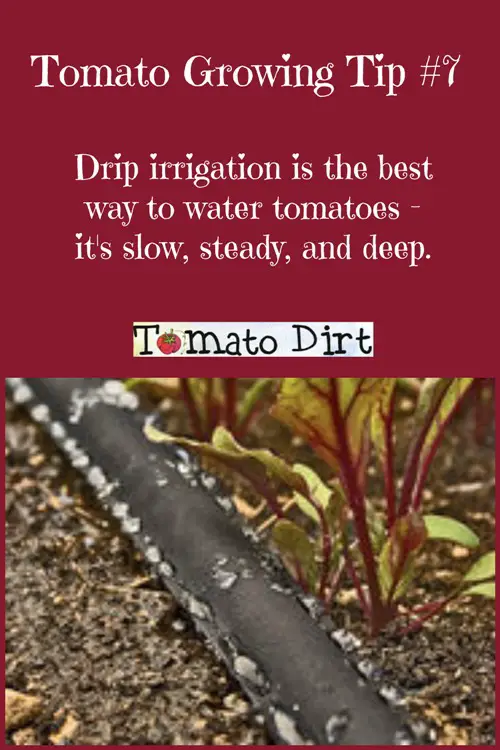Best Techniques for Watering Tomato Plants
Since 2010, Tomato Dirt has garnered 4.8+ million views, making it the web’s leading online source for growing tomatoes in the home garden. Award-winning writer and Tomato Dirt owner Kathy Widenhouse has helped thousands of home gardeners grow healthier tomatoes. Be one of them when you get Tomato Dirt’s Growing Guide here.
Updated 7.15.24
What's the best way to go about watering tomato plants?
Tomatoes do best when watered slowly and deeply.
As water sinks down lower into the soil, the tomato’s roots must follow suit and reach down further to absorb it.
Deep watering helps tomato plants build strong root systems.
Superficial watering allows roots to be lazy. If roots mustn’t dig deep, they can float around the surface and get a drink the easy way.
Shallow root systems can lead to root damage and more stress for the plant during dry spells. So by watering slowly and deeply, you're practicing your own kind of "Gardener's Tough Love" with tomato plants.
You can check the soil moisture before and after watering with a soil moisture meter. (Or you can do it quickly with your finger, too, and follow up with the meter to confirm your analysis.)
Most gardeners choose from 3 techniques:
| Technique | Advantages | Disadvantages |
|---|---|---|
| Hand-Watering | Requires just a hose and nozzle |
Time-consuming Supplies superficial watering only Concentrated stream means significant runoff |
| Sprinkler | Requires just a hose and sprinkler |
Wets leaves, creating greater opportunity for disease Higher evaporation, less soil absorption Waters whole garden, leading to more weeds in between rows |
| Drip Watering |
Little water lost to evaporation Allows slow and deep watering You can water anytime; can set drip on a timer Water while working in your garden Can re-use drip components year after year |
More costly to initially set up |
By far, gardeners get best results with drip watering. (This is one time in your life where it pays to be a real drip.)
Drip hoses (or soaker hoses) are the easiest and least expensive form of drip irrigation.
They are made of recycled tires and have tiny pores along their entire length.
Gardeners connect the drip hose to a water source and lay them along a row of tomatoes or wind them in between plants.
Water leaks slowly from the hose at a rate of about ½ gallon a minute per 100 feet of hose.
Drip Hose (Soaker Hose) Tips
1. Drip hoses work best when they lay flat.
2. Place hoses directly on top of the soil, not underneath it.
3. For best results, use 50 foot lengths or less as water seepage diminishes at hose ends.
4. Drip hoses may clog. Flush out hose by connecting it to a regular garden hose and turning on water to dislodge debris.
More on watering tomato plants ...
How Often Do You Water Tomato Plants?
How to Create Your Own Tomato Watering Schedule ...
Watering tomatoes when planting and just afterwards...
Watering tomato plants: the basics ...
Watering tomatoes: FAQs (Frequently Asked Questions) ...
How to know if you're watering tomatoes enought ...
How to water tomatoes in pots, containers, baskets ...
How to choose a garden hose for watering tomatoes ...
Watering gadgets: which ones do you need for growing tomatoes?
More watering tips on our Watering Tomatoes Pinterest board...
More on growing tomatoes ...
What's the best mulch for growing tomatoes?
How and when to mulch tomato plants ...
How to use tomato fertilizer to get best production ...
Kinds of tomato fertilizer ...
Organic tomato fertilizer: advantages and disadvantages
Pruning tomato plants: how and when to do it ...
Weeding tomatoes, how to control weeds in the tomato garden
Staking tomatoes for a bigger harvest ...
Return from Best Techniques for Watering Tomato Plants to Tomato Dirt home
As an Amazon Associate and Rakuten Advertising affiliate I earn from qualifying purchases.
SHARE THIS PAGE:
FREE! 10 Must-Know Tomato Growing Tips: 20-page guide
Get yours here:





New! Comments
Have your say about what you just read! Leave a comment in the box below.